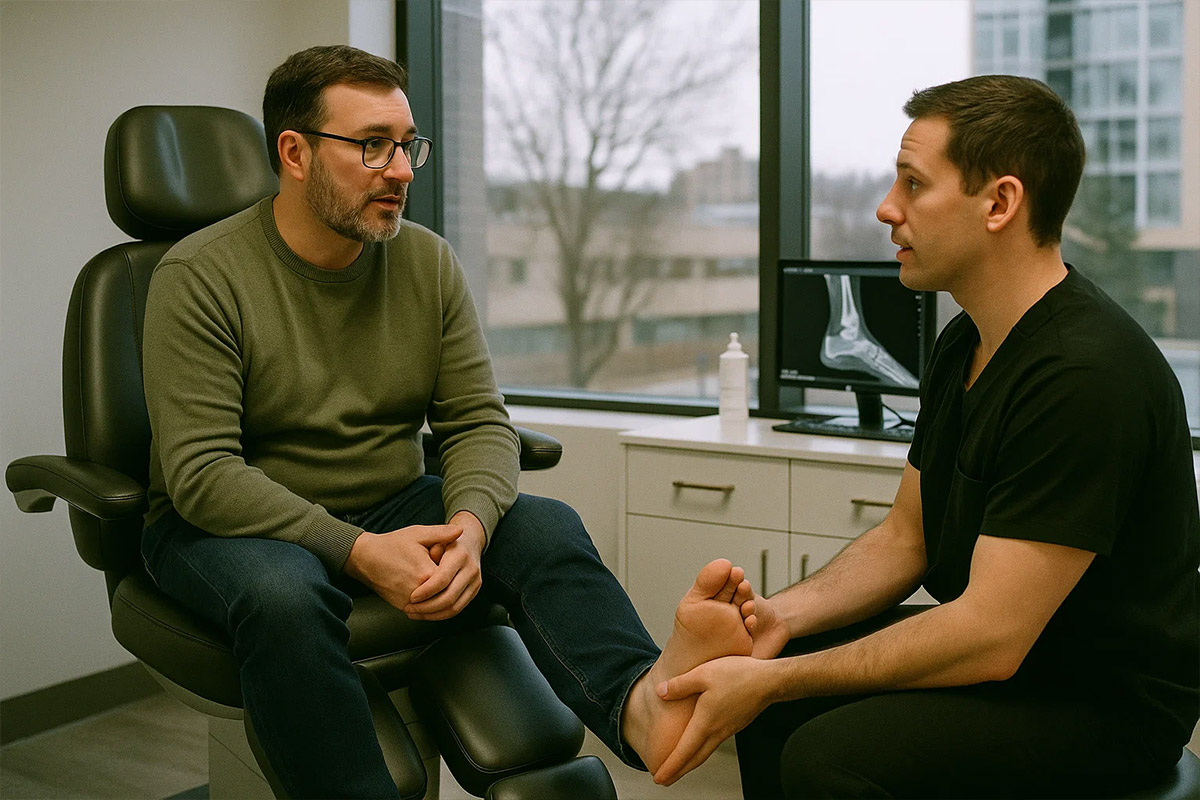
July 11, 2025
Foot pain can sneak up on you. Maybe you’ve been dealing with it for months, maybe even years. You’ve tried different shoes, over-the-counter inserts, ice packs, and rest—but nothing seems to fix the problem for good. At some point, you start to wonder: “Is surgery my only option now?”
At Step Ahead Podiatry, we help Edmonton patients answer that exact question. In this guide, we’ll walk you through the most common foot conditions that may require surgery, how to recognize the signs, and what to expect if you go down that road. Our goal? To help you feel informed and confident, whether you're ready for surgery or not.
Key Takeaways
- Surgery is usually considered after conservative treatments have failed.
- Conditions like bunions, fractures, arthritis, and tendon damage may require surgery.
- Step Ahead Podiatry offers same-day outpatient foot surgeries in Edmonton.
- Pain, reduced mobility, deformity, and recurring infections are common indicators.
- A consultation with a podiatrist can help determine your best course of action.
Understanding Foot Surgery
When you're dealing with foot pain that just won’t go away, it’s natural to start wondering what your options are—and for some people, foot surgery becomes part of the conversation. But surgery isn’t a one-size-fits-all solution, and it's not always the first thing we recommend.
In this section, we’ll walk you through what actually counts as foot surgery, and why most patients at Step Ahead Podiatry start with non-surgical care before exploring surgical options. The goal is to help you make an informed decision that fits your lifestyle and long-term health.
What Counts as “Foot Surgery”?
Foot surgery isn’t just one type of procedure—it covers a wide range of treatments aimed at fixing underlying issues in your feet and ankles. Depending on the condition, your surgery might be a quick, minimally invasive procedure or something more involved.
Here are a few examples that fall under the umbrella of foot surgery:
- Bunion correction (bunionectomy): Realigning the big toe and removing the bony bump.
- Hammertoe repair: Straightening out a curled toe that no longer responds to conservative care.
- Plantar fasciitis release: Cutting the ligament slightly to relieve chronic heel pain.
- Fracture repair: Repositioning bones and using hardware to stabilize a broken foot or ankle.
- Arthritic joint fusion: Fusing bones in joints severely damaged by arthritis to reduce pain.
- Neuroma removal: Taking out painful nerve tissue between the toes.
Each of these has the same end goal: to correct the root of the problem, reduce or eliminate pain, and restore as much function and mobility as possible. At Step Ahead Podiatry, we carefully evaluate your specific condition to determine which surgical (or non-surgical) path will be most effective.
Why It’s Not Always the First Option
We get it—surgery can sound intimidating. That's why we believe in a conservative approach whenever possible. At Step Ahead Podiatry, we always start by exploring non-invasive options before jumping into surgical solutions.
These first-line treatments often include:
- Custom orthotics to correct foot mechanics and relieve pressure
- Physical therapy to strengthen muscles and improve flexibility
- Footwear changes to reduce strain and promote natural movement
- Medication or injections to reduce inflammation and manage pain
In many cases, these conservative treatments can significantly improve your symptoms without the need for surgery. That said, if we’ve tried those routes and you’re still dealing with constant pain, limited mobility, or worsening deformities, surgery might be the most logical and effective next step.
Think of it this way: surgery isn’t giving up—it’s stepping up to get your life back. For many of our patients, it’s the turning point where things finally start to improve.
Common Foot Problems That May Require Surgery
1. Bunions
A bunion is a bony bump that forms at the base of your big toe, gradually pushing the toe toward the others and causing the joint to stick out. At first, bunions may be manageable with footwear changes and orthotics, but over time, they often worsen—leading to constant discomfort, swelling, and even joint stiffness. If you’re experiencing bunion pain that persists despite wearing supportive shoes, or if the deformity causes your big toe to overlap the others, it may be time to explore surgical options. At Step Ahead Podiatry, we offer surgical bunion correction that realigns the joint, restores function, and relieves pain so you can get back to walking comfortably. Left untreated, bunions often become more painful and harder to treat, making early evaluation important.

2. Hammertoes
A hammertoe is a deformity that causes one or more of your smaller toes to bend at the middle joint, giving it a hammer-like appearance. This often results from muscle imbalances, poorly fitting shoes, or underlying structural issues in the foot. In the early stages, the toe may still be flexible and respond to padding, splints, or shoe modifications. But as the condition progresses, the toe can become rigid and stuck in a bent position, leading to corns, calluses, and constant discomfort—even when you're barefoot. When conservative treatment fails and pain interferes with your daily activities, surgical correction for hammertoe may be the most effective option. At Step Ahead Podiatry in Edmonton, our surgeons can straighten the affected toe, remove painful corns, and improve your overall foot function.
3. Plantar Fasciitis (Chronic Cases)
Plantar fasciitis is one of the most common causes of heel pain, caused by inflammation of the thick band of tissue (plantar fascia) that runs along the bottom of your foot. Most people can find relief with rest, custom orthotics, stretching routines, or anti-inflammatory treatments. But for a small percentage of patients, the pain doesn’t go away—it lingers for months and starts to impact quality of life. If you've been managing chronic heel pain for over 6 to 12 months and it continues to interfere with walking, standing, or working, you may be a candidate for plantar fasciitis surgery. This minimally invasive procedure releases tension in the plantar fascia, relieving pressure and reducing inflammation. Step Ahead Podiatry offers this procedure to patients in Edmonton who have exhausted all non-surgical options and are ready for lasting relief.
4. Foot and Ankle Fractures
Fractures in the foot and ankle are common, especially from falls, sports injuries, or accidents. While many heal well with immobilization and physical therapy, some fractures don't heal properly—leading to chronic pain, misalignment, and reduced mobility. You may notice stiffness, swelling, or difficulty bearing weight long after the injury has occurred. If your foot or ankle fracture hasn’t healed as expected, or if you’re still experiencing discomfort despite rest and rehab, surgical intervention may be necessary. Surgery can realign broken bones, secure them with screws or plates, and promote proper healing. At Step Ahead Podiatry, we provide expert surgical care for complex fractures to help patients in Edmonton regain their strength, stability, and comfort.
5. Arthritis in the Foot or Ankle
Arthritis in the foot or ankle can be incredibly debilitating, especially when it affects multiple joints. Over time, arthritis can cause cartilage to wear away, resulting in bone-on-bone friction, joint swelling, and constant pain. You may find it hard to walk, wear shoes comfortably, or keep up with your usual routine. When conservative treatments like orthotics, pain relief medication, and physical therapy no longer help, foot or ankle surgery for arthritis may be the next step. Depending on your condition, surgical options at Step Ahead Podiatry include removal of bone spurs, joint fusion to eliminate painful movement, or total joint replacement in advanced cases. Our Edmonton-based team will help determine the right surgical path to reduce pain and restore function.
6. Tendon Tears or Ruptures
Tendons are strong bands of tissue that connect muscles to bones, allowing movement and stability. When a tendon is partially torn or fully ruptured, it can severely impact your ability to walk, push off your foot, or even stand without pain. This is especially true for injuries involving the Achilles tendon, which is crucial for mobility. You may notice sudden pain, swelling, bruising, or weakness in the affected area. In most cases of full tendon rupture or significant tearing, surgical repair is recommended to restore normal function and prevent further complications. At Step Ahead Podiatry, our surgical team performs precise tendon repairs to reconnect torn tissues and support a smooth, complete recovery. Edmonton patients who undergo tendon surgery at our clinic receive personalized care, advanced imaging, and follow-up rehab support to help them return to everyday activities with confidence.
Signs It Might Be Time for Foot Surgery
1. Constant Pain That Doesn’t Go Away
Pain that lingers for months, even with treatment, is one of the biggest indicators.
2. Structural Deformity
When your foot looks visibly different—think bunions, claw toes, or a collapsing arch—it may be time for surgical correction.
3. Limited Mobility or Balance Issues
If walking becomes a struggle or you start avoiding activities you used to enjoy, your foot issue may need more serious intervention.
4. Chronic Swelling or Inflammation
If inflammation doesn’t subside with ice, rest, or medication, it could be due to internal damage that needs to be repaired surgically.
5. Failed Conservative Treatments
Tried everything and still no improvement? That’s a strong sign you need a surgical consult.

What to Expect During Foot Surgery at Step Ahead Podiatry
Consultation & Assessment
Before any procedure, we conduct a full evaluation—imaging, gait analysis, and a deep dive into your symptoms. We’ll walk you through your options and answer every question.
Minimally Invasive Options
Where possible, we use techniques that involve smaller incisions, less pain, and faster recovery.
Our Surgical Facilities
Step Ahead Podiatry has a certified private surgical suite, plus privileges at the Alberta Surgical Centre. Many procedures are done on an outpatient basis.

Foot Surgery Recovery Timeline
1–2 Weeks
- Rest and keep the foot elevated
- Use crutches or walker as needed
2–6 Weeks
- Gradual return to weight-bearing activities
- Begin physical therapy if prescribed
6+ Weeks
- Swelling reduces
- Resume most activities with proper footwear
- Continued follow-up at Step Ahead Podiatry for progress checks
Tips to Support Your Healing
- Follow post-op instructions exactly
- Keep your dressing clean and dry
- Avoid rushing back to full activity too soon
- Use custom orthotics to prevent future issues

Why Choose Step Ahead Podiatry for Foot Surgery in Edmonton?
- Experienced team: Decades of combined foot and ankle surgical experience
- Private surgical suite: Convenient access, no long hospital waits
- Personalized care: We tailor treatment plans based on your lifestyle and condition
- Convenient follow-up: Local care, quick scheduling, and thorough post-op guidance
Final Thoughts: Should You Consider Foot Surgery?
Surgery isn’t something anyone rushes into—but it can be life-changing when chronic pain and dysfunction start to affect your day-to-day life. If you're dealing with long-standing foot pain or a condition that hasn't improved with treatment, it's worth talking to a podiatrist.
At Step Ahead Podiatry, we’re here to give you honest answers, walk you through your options, and provide expert care if surgery is the right move.
Next Step: Book Your Consultation
Think it might be time to consider foot surgery? Contact Step Ahead Podiatry today to book a thorough foot assessment. We’ll help you decide if surgery is necessary—or guide you toward the right alternatives to get you back on your feet.
Not what you were looking for? Step Ahead Podiatry also offers the following:
Step Ahead Podiatry’s Top Resources on Foot Pain:
American Podiatric Medical Association (APMA) on Foot Health

